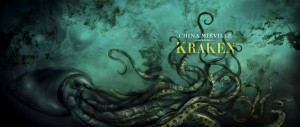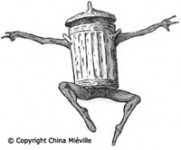True Story: The first in-depth article I read regarding China Miéville was a NY Times article about The Kraken, his latest novel (2010). I found this article because (of course) Neil Gaiman linked it in his blog. (Or maybe on twitter, since I can’t seem to find it on the blog.) It was this article, along w/Neil’s recommendation, that got him on my list of authors to check out. After The Scar, I knew I’d be keeping track of his work. But I just finally read The Kraken, after four other books by Miéville. And I’d forgotten that the article was about this one until I went looking for a pic for this blog.

The Kraken is my favorite so far, though I’ve loved everything I’ve read. Here are today’s reasons why I am in love with China Miéville:
1) I don’t always understand what the heck he’s talking about. This is rare, especially in a work of fiction.
2) Even when I don’t understand exactly he’s talking about, I’m not irritated by it. It’s not bad writing, it’s fantastic writing that comes across as reality – we don’t always know what the heck is going on! I’m right there with the rest of the characters. Most of them manage to muddle through somehow, like we all do.
3) He loves to play with words. He makes up words for concepts that don’t currently exist (in mainstream culture, at least) and plays with the language while labeling them.
4) He’s not ashamed of his geek flag, and slips his pop culture references in with originality and tons of humor.
5) I’ve yet to guess more than 50% of any story (of his) that I’ve read (4 novels & one short story collection), and never been disappointed. Many of his plot twist are not just surprising, but truly mind-blowing. As in: I have to put the book down and marvel at the new place he’s taken me in my brain. He doesn’t take things to the next level – he skips 100 steps and lands somewhere much more shocking, and rearranges everything you just read into something new and even more impressive. All without breaking the tension.
Go. Read.

